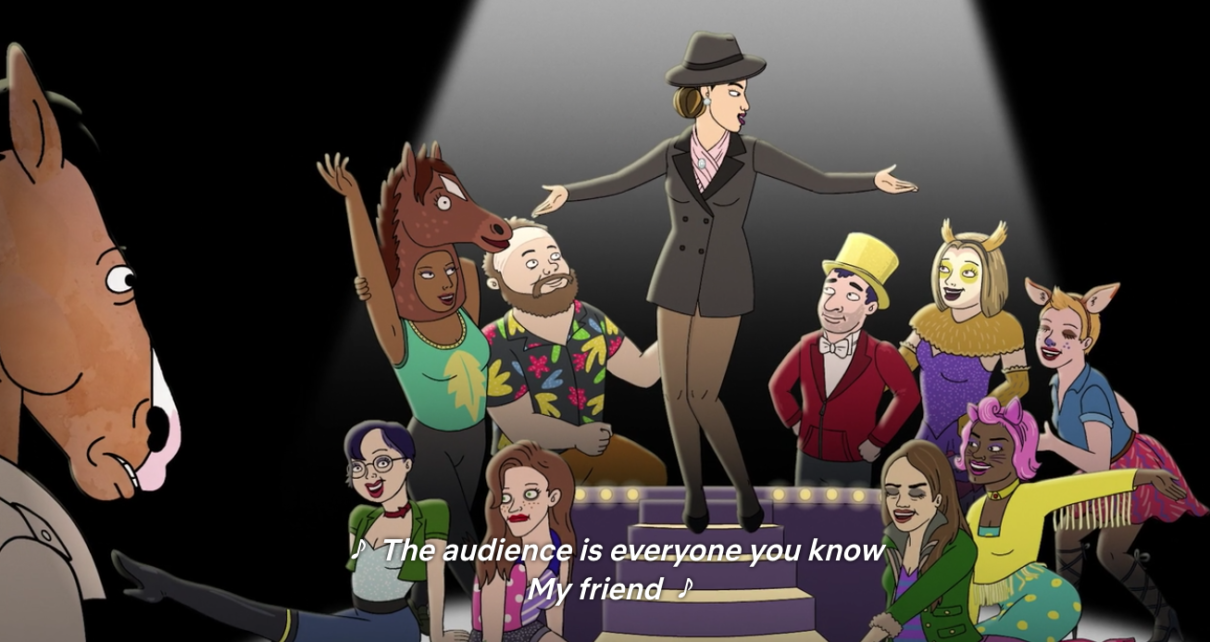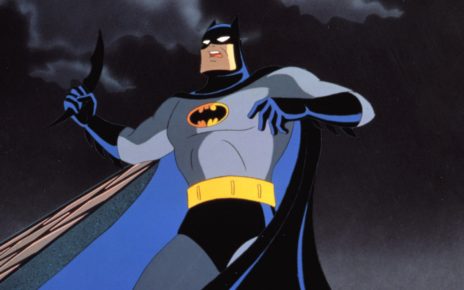
Welcome to What Horse Is He Right Now Dot Com, a collection of stories by The Dot and Line about BoJack Horseman Season 5. Spoilers for Season 5 follow.
The dissonance between joy and pain is all there in “The Showstopper,” the penultimate episode of BoJack Horseman’s Season 5. The episode knows when to play it straight and when to devastatingly subvert expectations. This is typical of the show itself: a sweet sadism that keeps us coming back for more.
The choice to use a Broadway musical number to illustrate Bojack’s increasingly surreal breakdown alone is kind of genius; in many actual musicals, songs often very clearly illustrate something that’s only going on in the characters’ heads, and we’re meant to understand that, “no, they’re not all REALLY breaking into song,” which is perfect here. We instantly know this isn’t real, but a drug trip, when so much of this season is asking what’s real — and what’s not.
The musical number comes in the last third of Episode 11, so fans already know it’s going to be rough. And, true to BoJack Mood Whiplash form, the song starts off with a particularly silly moment with Todd’s sex robot. Before you’re even done laughing, shit gets, well, real. The lighting changes, and the walls drop away from BoJack as if they’re two-dimensional, fake stage backgrounds, leaving him on the empty, dark Philbert set, caught uncomfortably in the spotlights. Then, they’re gone.
The Setup
Out of the dark comes leading lady Gina, played by an incredible Stephanie Beatriz.
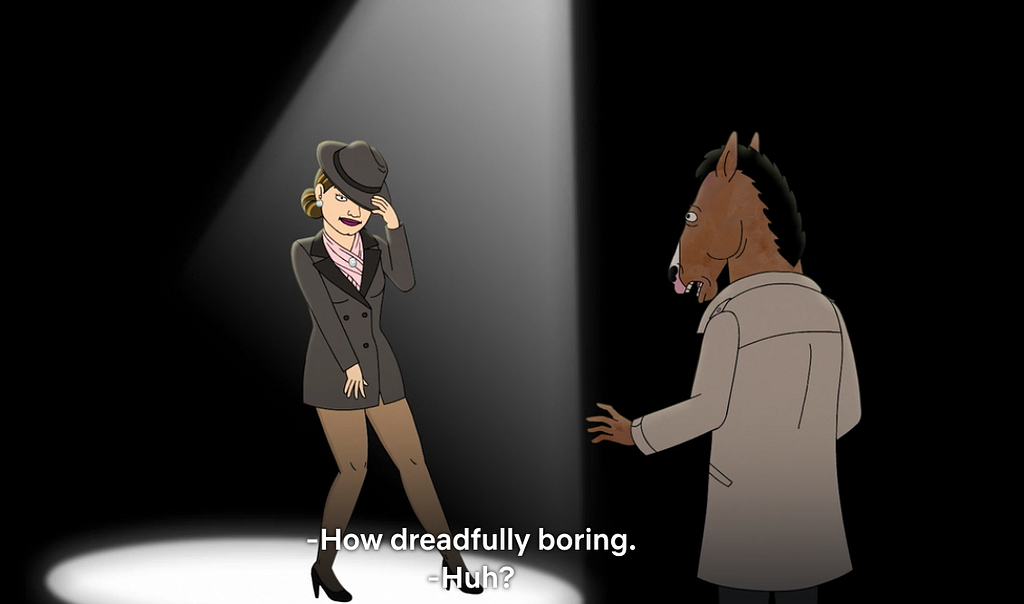
I love her starting costume — it’s a very Musical Theater Version of a pulp-noir ’40s detective outfit, complete with fishnet seams in the backs of her stockings. Perfect for what Bojack’s going through right now…except Gina’s not entirely on board.
“So what? You solve this little mystery, fix this little hole, and everything will be fine?” She’s got him figured out. “You don’t want that. For everything to be fine? How dreadfully boring.”
And away we go, into a completely convincing classic Broadway act one finale song. Not quite the climactic ensemble showstopper, but a going-out-on-a-high-note solo number musicals traditionally deliver around the end of a first act. It’s mostly upbeat and jazzy, with shades of Cabaret, Carousel, Wicked, and Chicago (I’ll come back to that one), and maybe some Sinatra thrown in.(Terribly ironically, I keep hearing the jazz standard “The Best Is Yet To Come” in the instrumentals.) There’s a little “Pure Imagination” from Charlie and the Chocolate Factory dashed in here, too—and, like the infamous tunnel scene, this piece goes from charming to hellish in no time flat.
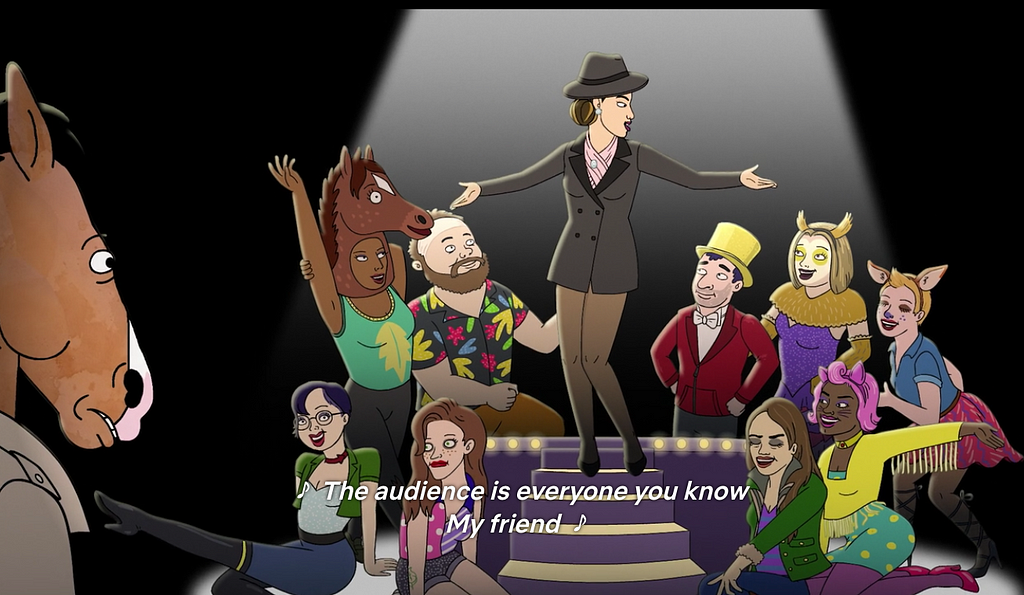
The Players
First, we meet the cast of major players in BoJack’s life, frozen in a smiling tableau: Diane, Hollyhock, Sarah Lynn, Herb, Todd, Charlotte, Penny, Princess Carolyn, and Kelsey (the director who offered him a chance to work on actual serious pieces, “with a director who really sees you,” instead of Secretariat).
Two interesting things here. Firstly, of the nine people onstage — 10, counting Gina — there are only two men, and Mr. Peanutbutter, surprisingly, isn’t one of them. Does that mean we’re seeing not only the most significant people in BoJack’s life, but only the ones he feels he’s wronged? Secondly, everybody, even the animals, are played by humans. Some of the actors are pretty spot-on, like Herb and Kelsey, and Todd’s pretty close. But some are exaggerated, like Diane’s (new-haircut-inspired?) perkiness and Sarah Lynn’s haunting, ventriloquist’s dummy–like stare.
And then, the first gut-punch of the number. Gina takes Sarah Lynn’s hand and pulls her into motion, singing “Leave them with a smile when you go!” — and the backdrop changes to the planetarium where she overdosed at the end of Season 3. Sarah Lynn pirouettes away across a field of stars. Ouch. Ow.

From there, more backdrops slide across the “stage,” this time featuring significant location from the show’s prior seasons: BoJack’s house, the Escape From L.A. boat, the Hollywoo sign and its big missing D, the Old Sugarman Place, and Griffith Park. Mr. Peanutbutter’s house appears directly behind BoJack (but the dog himself is still nowhere to be seen).
Then we see another familiar “place’”— the TV from Bojack’s childhood, with Secretariat, also played very obviously by a human, on The Dick Cavett Show. Gina steps right up into the screen, and we get the first central line of the song (and, if you think about it, the show entirely): “Don’t stop dancing ‘till the curtains fall!”
The Flashbacks
The curtains aren’t all that’s falling. Gina cranks a lever, and bam, Bojack drops through a trap door and into another surreal set of cardboard stand-ups. This time, they’re significant moments in time…and none of them are good.
Every scene is also also exaggerated, and not just in a campy “this is a Broadway musical” way. The very dramatic physicality of the figures gives an instant impression of the emotions behind each scene — and some of them are truly interesting choices that go against what might be expected.
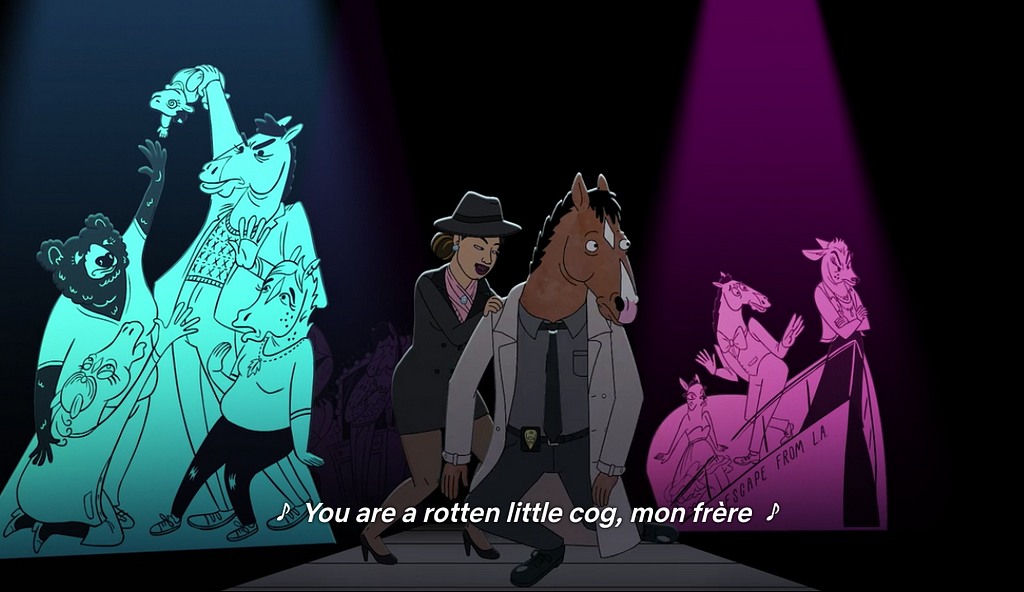
First, BoJack sadistically holds Doll, Beatrice’s surrogate “baby” from last season, above her as his mother, Hollyhock, and Tina the nurse all tearfully try to save Doll. BoJack’s fury, as well as the smallness of both Beatrice and Hollyhock, are both exaggerated. (The bright blue monochrome and the exaggerated version of the scene also bring the episode “Stupid Piece of Shit” instantly to mind.)
On the deck of the Escape From L.A., however, BoJack appears like a hapless rube caught in a romantic comedy; with his oversized Vaudevillian bowtie and cartoony body language, you almost expect him to say, “Aw, gosh golly gee, wouldja just look at what I’ve gotten myself into this time?” On one side, an angry Charlotte (in a fancy evening gown? BoJack has always seen her as a dignified and sophisticated lady) bursts in on him very much not touching an angry Penny, who stands with her arms folded and back to him. Is this BoJack feeling guilty but rationalizing again, suggesting he was an innocent patsy caught in the middle of a family drama? Or does it suggest that he really isn’t quite as culpable as he’s said before?
Then, in pink, we get a tiny peek of something only alluded to: something happened between BoJack and Sharona, the makeup artist from Horsin’ Around. She’s leaving, or maybe ignoring him, and he’s looking caught between lovestruck and distressed. We can guess it’s something BoJack feels he screwed up.
And as Gina sings “you are a rotten little cog, mon frère, spun by forces you don’t understand,” we see Bojack laboring like Sisyphus under the weight of the Hollywoo sign’s missing letter D. That’s a pretty clear opinion on his lot in life there, plus a nice “cog” reference to WhatTimeIsItRightNow.com and BoJack’s role as a tiny, rotten, and ultimately replaceable part in a huge machine.
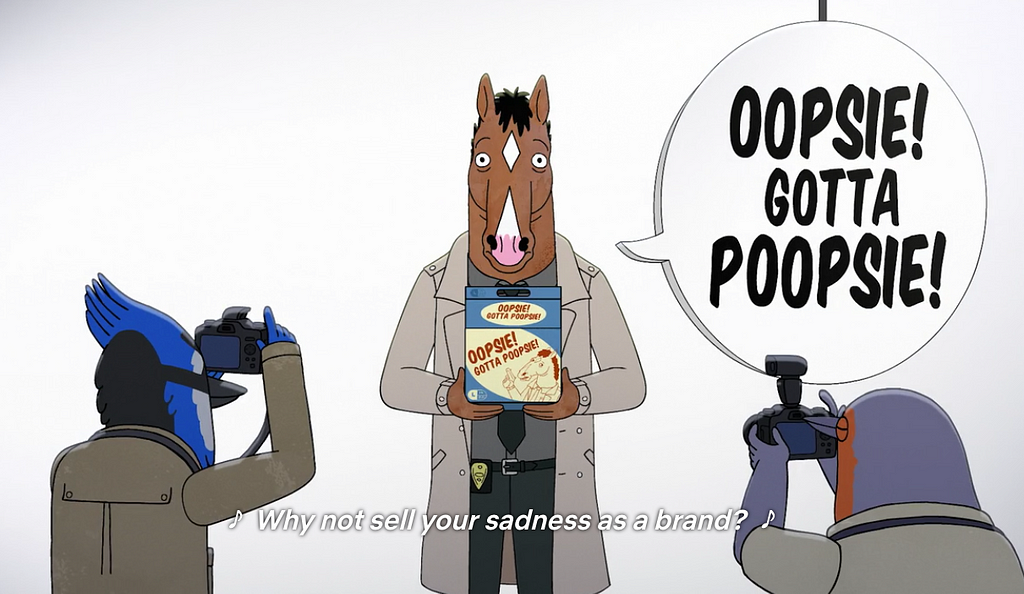
The Sellout
Soon, we spin from the (fake) Old Sugarman Place to a commercial: “Living is a bitter, nasty slog, mein herr, why not sell your sadness as a brand?” (Or fetishize it? Capitalize on it? Commercialize that trauma.) “Paint your face and brush your mane and find someplace to cut your pain to portions we can buy at the mall!”
He passes billboards selling campy Philbert merch (“Oopsie, Gotta Poopsie!,” the completely immature and absurd catchphrase for one of the show’s corporate sponsors, just underscores how very not funny the rest is). The car BNoJack drives is different, but the road itself looks like the stretch of highway he ended up on in the Season 3 finale — and the site of one of his suicide attempts as he let the steering wheel go.
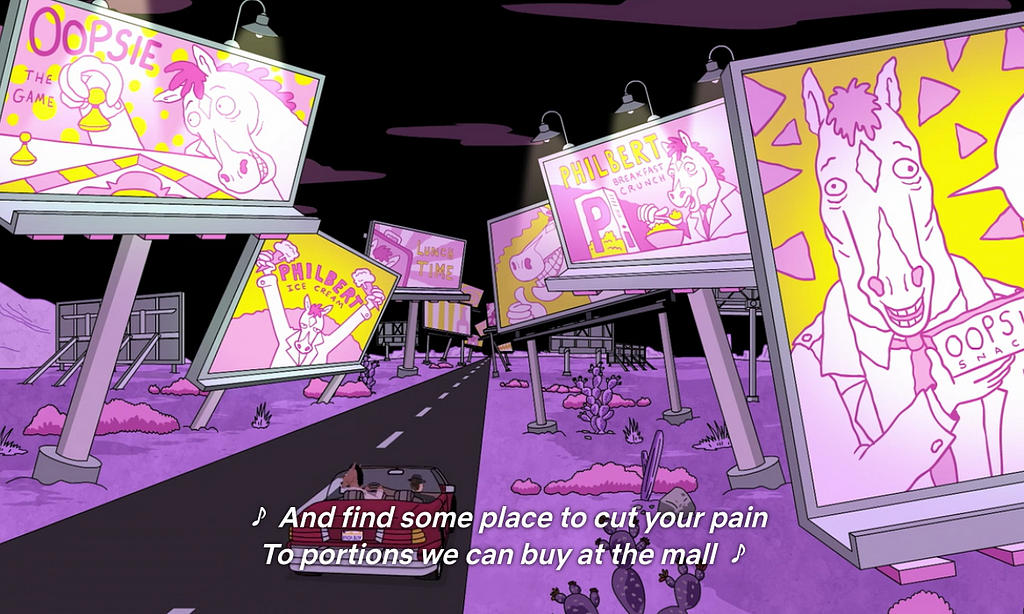
“Aw, shucks!”
Bam, it’s dark again, but BoJack’s not in the spotlight this time. Instead, it’s Beatrice (also played by a human) center-stage, tap-dancing circles around him — how’s that for a spot-on visual metaphor ?— which calls back the moment in Episode 6 where he eulogizes her and recalls the one time she looked free and powerful: dancing. At least, until she dances right into a coffin, with a little parting curtsy.
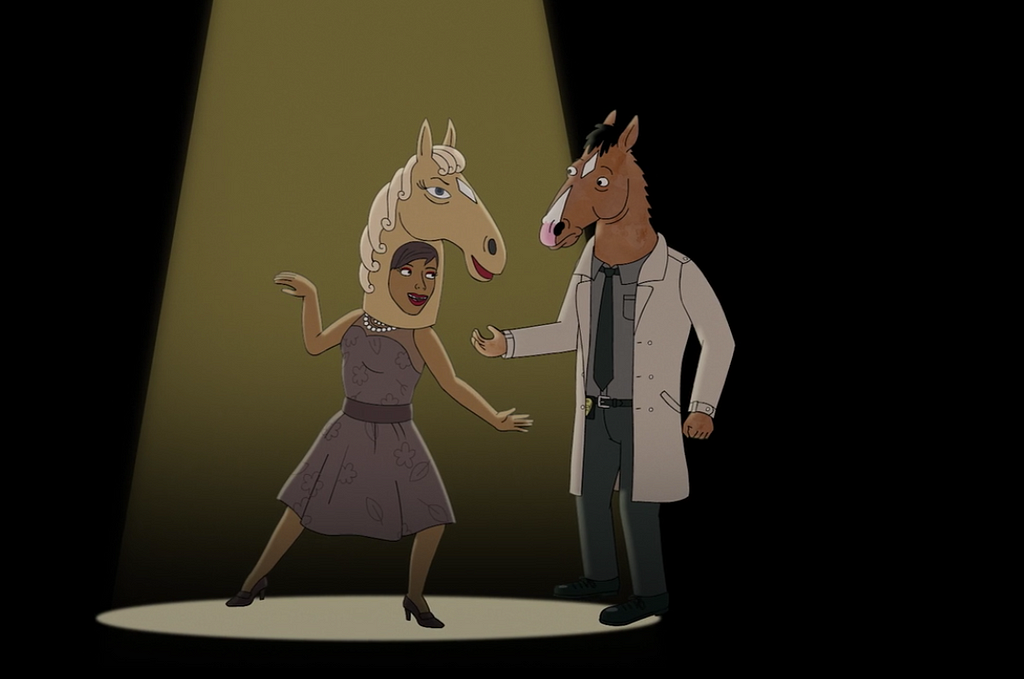
And now we’re building up even more, because here comes giant inflatable Bojack floating above his name in lights. The first thing this reminded me of was “Roxie” from Chicago. Roxie’s name gets the same treatment, and the song is a bright-on-the-surface, dark-underneath number about fame, getting “love” from an audience, and its price. It also, however, looks like King Herod’s light-up name in the 2000 film version of Jesus Christ Superstar, which would really highlight the hubris and ultimate absurdity of that name-in-lights trope. Speaking of, this entire song, with its cheery-to-devastating dichotomy, hits a lot like “Something To Sing About” from Once More With Feeling, the Buffy the Vampire Slayer musical. (Broadway really is great for perky pain.)
The Kicker
Suddenly, Gina takes her place on top of BoJack’s name—much smaller now, but dancing all over it in heels — and everywhere she steps, the lights flicker out with a jarring “zzzap!” sound effect.

Now the lyric dissonance gets cranking it up to eleven: “Grief consumes you, but you just keep grinnin’! The ache becomes you, and it’s just beginning! Don’t stop dancing! Nothing’s certain but the curtain!”
BoJack turns back to the giant balloon version of him, which suddenly deflates and violently flies toward him, and then—holy shit—when it hits him, his face hits the “screen,” which shatters into shards of glass, blood spurting from his face at the impact. It looks for all the world like he’s hitting the windshield in a high-speed car wreck. You know, like what happened earlier this season. And almost happened back in Season 3 — it’s hard to shake the feeling that we just saw what a successful suicide-by-car attempt there might have looked like. Curtains for BoJack.

Good thing it’s over. (Or is it?) Bojack wakes up in his own (?) bed, next to Gina (or Sassy?). But the “show” isn’t over. Are we on the Philbert set? Or in BoJack’s house where his grasp on reality is quickly slipping? In one last mood zigzag, there’s no singing or dancing—but what happens next is so brutal, even Les Misérables can’t match it.

Thanks for reading The Dot and Line, where we talk about animation of all kinds. Don’t forget to for this article and follow us on Twitter and Facebook.


